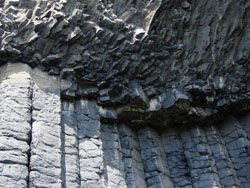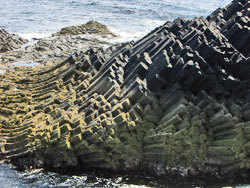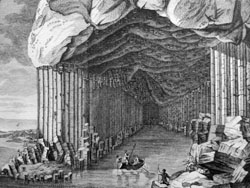Staffa
Inner Hebrides, Scotland
 The People’s Choice
The People’s Choice
'A familiar location to many geologists'
From Iain Neill on Facebook

The island of Staffa is composed of columnar basalt and overlying ‘slaggy’ basalt, erupted as lava flows from the Palaeogene Mull volcanic centre.
The lava flows on the island were erupted early in the history of the Mull volcanic centre, which forms part of the North Atlantic Palaeogene Igneous Province, along
with the other centres of Skye, Arran, Ardnamurchan, Rum and St. Kilda.. The columnar jointing, commonly found in these flows is typical of the early lava flows only.
 The presence of ash layers and thin soil horizons indicate explosive activity and intervening quiet periods respectively.
The presence of ash layers and thin soil horizons indicate explosive activity and intervening quiet periods respectively.
The composition of these lava flows also differs from the later flows by being the most silica-rich flows – thought to have formed due to shallower accumulations of the magma before eruption. These flows are known as the Staffa Magma Type member and are also seen at Carsaig, Ardtun, Ulva and near Tobermory.
'Fingal’s Cave’ on the Isle of Staffa is internationally famous, having been the inspiration for musicians, artists, poets and writers for many years, most notably for Mendelssohn’s ‘Hebridean Overture’.

The island and cave was brought to the attention of the scientific world by Sir Joseph Banks (1743 – 1820) who was on route to Iceland on a natural history trip. In his writings he compares the island’s appearances to lava, and it should be noted that this came before Hutton’s ‘Theory of the Earth’.
Text: Scottish Geology
Explore Staffa on Google Street View